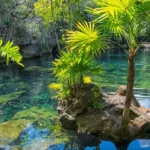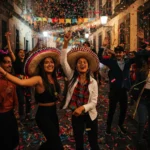Kirkjufell: Iceland’s Iconic Landmark
Kirkjufell, often called “Church Mountain” due to its unique shape, is one of Iceland’s most recognizable and photographed landmarks. Located on the Snæfellsnes Peninsula, this majestic mountain rises dramatically from the surrounding landscape, creating a breathtaking sight that has captured the imaginations of travelers and photographers alike.
Kirkjufell’s distinctive silhouette, resembling a pointed church steeple, is a result of centuries of volcanic activity and glacial erosion. Its striking appearance is further enhanced by the surrounding natural beauty, including the nearby Kirkjufellsfoss waterfall, black sand beaches, and the vast expanse of the North Atlantic Ocean.
Whether you’re a seasoned adventurer or a casual sightseer, Kirkjufell offers a memorable experience. You can hike to its base, capture stunning photos from various angles, or simply admire its grandeur from afar. No matter how you choose to experience it, Kirkjufell is sure to leave a lasting impression.
How to Get to Kirkjufell
Reaching Kirkjufell is relatively easy, as it’s conveniently located along Route 54 on the Snæfellsnes Peninsula. If you’re driving from Reykjavik, the journey takes approximately 2.5-3 hours, depending on traffic and road conditions. The drive itself is scenic, with stunning landscapes unfolding before your eyes.
For those who prefer not to drive, several tour operators offer day trips from Reykjavik to Kirkjufell and the Snæfellsnes Peninsula. These tours typically include transportation, a knowledgeable guide, and stops at other notable attractions in the area. It’s a convenient option for those who want to sit back, relax, and enjoy the scenery without the hassle of driving.
If you’re traveling from other parts of Iceland, you can reach the Snæfellsnes Peninsula via various routes, including the Ring Road (Route 1) and other regional roads. It’s worth noting that road conditions in Iceland can vary depending on the season, so it’s always a good idea to check the latest updates before you embark on your journey.
Best Time to Visit Kirkjufell
The best time to visit Kirkjufell depends on your preferences and what you hope to experience. Each season offers a unique perspective of this iconic landmark.
Summer (June-August): During the summer months, the weather is generally mild, with long daylight hours, making it ideal for hiking and outdoor activities. The landscape is lush and green, and you might even spot some wildflowers blooming around Kirkjufell.
Autumn (September-October): As autumn arrives, the colors transform, painting the landscape in vibrant hues of red, orange, and yellow. The crowds thin out a bit, and you can enjoy a more peaceful experience at Kirkjufell.
Winter (November-February): In winter, Kirkjufell is often blanketed in snow, creating a magical and ethereal atmosphere. If you’re lucky, you might even witness the Northern Lights dancing above the mountain.
Spring (March-May): Spring brings a sense of renewal as the snow melts and the landscape awakens. The weather can be unpredictable, but the days start to get longer, offering more opportunities for exploration.
Photographing Kirkjufell
Kirkjufell is a photographer’s paradise, offering endless opportunities to capture stunning images. The mountain’s unique shape, the nearby waterfall, and the dramatic landscape provide a wealth of subjects to explore.
For the best photos, try to capture Kirkjufell during the golden hour – the period shortly after sunrise or before sunset when the light is soft and warm. This creates a magical atmosphere and enhances the colors in your photos.
Don’t be afraid to experiment with different angles and perspectives. You can shoot from the base of the mountain, from across the nearby river, or even from a higher vantage point for a panoramic view.
If you’re visiting during the winter months, consider capturing Kirkjufell under the Northern Lights for a truly unforgettable shot.
Hiking Around Kirkjufell
While Kirkjufell itself isn’t climbable, there are several hiking trails in the surrounding area that offer breathtaking views of the mountain and its surroundings.
One popular option is the Kirkjufell Circle Trail, a relatively easy 2-3 hour hike that takes you around the base of the mountain and along the coast. The trail is well-marked and suitable for hikers of all levels.
For a more challenging adventure, consider hiking to the top of Helgafell, a nearby mountain that offers panoramic views of the Snæfellsnes Peninsula, including Kirkjufell. The hike is steeper and takes longer, but the rewards are well worth the effort.
Remember to wear appropriate footwear and clothing for hiking, as the weather in Iceland can change quickly. It’s also a good idea to bring plenty of water and snacks to keep you energized.
Kirkjufellsfoss: The Must-See Waterfall
Kirkjufellsfoss, often simply called “the Kirkjufell waterfall,” is a picturesque cascade that tumbles down a rocky slope just a short walk from the mountain. It’s a popular spot for photographers and visitors alike, offering a stunning foreground to the iconic peak.
The waterfall is easily accessible via a short path from the parking area, making it a convenient stop for those with limited time. You can walk right up to the base of the falls, feel the mist on your face, and capture breathtaking photos of the water cascading down.
The best time to visit Kirkjufellsfoss is during the summer months when the water flow is at its peak. However, it’s worth noting that the falls can freeze over in winter, creating a unique and icy spectacle.
Nearby Towns & Accommodation
While there isn’t a town directly at Kirkjufell, there are several charming villages and towns within a short drive where you can find accommodation, dining options, and other amenities.
Grundarfjörður, located about 7 km (4.3 miles) from Kirkjufell, is the closest town and offers a range of hotels, guesthouses, and restaurants. It’s a great base for exploring the Snæfellsnes Peninsula and offers stunning views of Kirkjufell across the bay.
Ólafsvík, located further north on the peninsula, is another option for accommodation. It’s a historic fishing village with a charming harbor, museums, and a variety of shops and restaurants.
Stykkishólmur, located on the northern coast of the peninsula, is a larger town with a wider range of accommodation options, including hotels, guesthouses, and campsites. It’s also a popular departure point for boat tours to the nearby islands.
What to Pack for Kirkjufell
Packing for Kirkjufell requires careful consideration, as the weather in Iceland can be unpredictable. Here are some essentials to include in your packing list:
- Waterproof and windproof jacket: This is essential for protecting yourself from the elements, as rain and wind are common in Iceland.
- Warm layers: Even in summer, temperatures can drop, so be sure to pack warm sweaters, fleeces, and thermal underwear.
- Hiking boots or sturdy shoes: If you plan on hiking around Kirkjufell or exploring the surrounding area, comfortable and waterproof footwear is a must.
- Hat, gloves, and scarf: These are essential for keeping warm, especially during the colder months.
- Camera: You’ll want to capture the stunning scenery of Kirkjufell, so don’t forget to bring your camera and extra batteries.
- Sunscreen and sunglasses: The sun can be strong in Iceland, even on cloudy days, so protect your skin and eyes.
- Insect repellent: In the summer months, midges (small biting insects) can be a nuisance, so bring insect repellent for protection.
Exploring the Snæfellsnes Peninsula
Kirkjufell is just one of many highlights on the Snæfellsnes Peninsula, often referred to as “Iceland in Miniature” due to its diverse landscapes and attractions. While you’re in the area, be sure to explore some of the other gems this region has to offer.
Some must-visit attractions include the dramatic basalt cliffs of Lóndrangar, the black sand beach of Djúpalónssandur, the charming fishing village of Arnarstapi, and the majestic Snæfellsjökull glacier, which inspired Jules Verne’s “Journey to the Center of the Earth.”
You can also go whale watching, take boat tours to the nearby islands, or simply drive along the scenic coastal roads, stopping at viewpoints and exploring hidden coves along the way. The Snæfellsnes Peninsula is a treasure trove of natural beauty and cultural heritage waiting to be discovered.
Kirkjufell’s Cultural Significance
Kirkjufell holds a special place in Icelandic folklore and culture. It’s said to be the site where the first settlers of Iceland landed, and it has been featured in numerous Icelandic sagas and poems.
The mountain is also associated with the mythical creature Bárður Snæfellsás, a half-human, half-troll who is said to reside in Snæfellsjökull glacier. According to legend, Bárður was a protector of the region and is still revered by many Icelanders today.
In recent years, Kirkjufell has gained even more fame through its appearance in popular TV shows and movies, such as “Game of Thrones.” This has further cemented its status as a cultural icon and a must-visit destination for fans of the show.
Local Cuisine & Dining Tips
While visiting Kirkjufell, be sure to sample some of the delicious local cuisine. Icelandic cuisine is known for its fresh seafood, lamb dishes, and unique flavors.
In the nearby towns of Grundarfjörður and Ólafsvík, you’ll find a variety of restaurants offering traditional Icelandic dishes as well as international cuisine. Some popular local specialties include plokkfiskur (fish stew), hangikjöt (smoked lamb), and skyr (a thick, creamy yogurt).
For a truly unique dining experience, consider trying hákarl (fermented shark), a traditional Icelandic delicacy that is known for its pungent smell and acquired taste. It’s not for everyone, but it’s definitely an experience you won’t forget!
Sustainable Travel in Kirkjufell
As a responsible traveler, it’s important to minimize your impact on the environment and support sustainable tourism practices in Kirkjufell. Here are a few tips:
- Respect the environment: Stay on designated trails, avoid littering, and be mindful of the fragile ecosystem.
- Choose eco-friendly accommodations: Look for hotels, guesthouses, or campsites that prioritize sustainability and have eco-certifications.
- Support local businesses: Buy local products, dine at local restaurants, and participate in activities offered by local tour operators.
- Reduce your carbon footprint: Consider carpooling, taking public transportation, or renting a hybrid or electric vehicle.
- Learn about Icelandic culture and customs: Show respect for local traditions and customs, and learn a few Icelandic phrases to connect with the locals.
By following these tips, you can help preserve the natural beauty of Kirkjufell and ensure that future generations can enjoy this iconic landmark for years to come.











